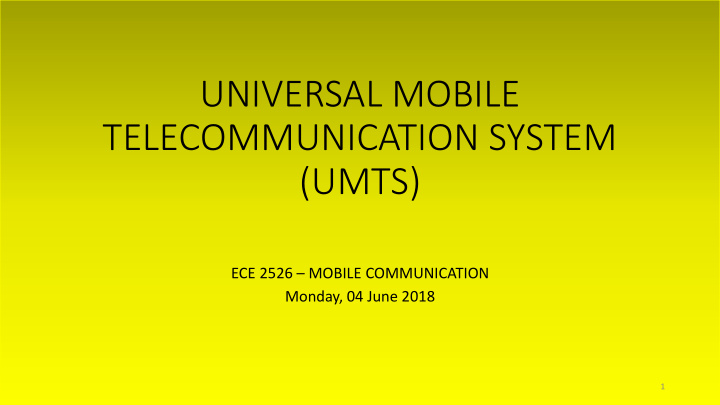



UNIVERSAL MOBILE TELECOMMUNICATION SYSTEM (UMTS) ECE 2526 – MOBILE COMMUNICATION Monday, 04 June 2018 1
WHAT IS UMTS? 1. The U niversal M obile T elecommunications S ystem (UMTS) is a third generation mobile cellular system for networks based on the GSM standard. 2. It was developed and is maintained by the 3GPP (3rd Generation Partnership Project). 3. UMTS is a component of the International Telecommunications Union IMT-2000 standard 4. UMTS is similar to the CDMA2000 standard 5. UMTS uses wideband code division multiple access (W-CDMA) radio access technology to offer greater spectral efficiency and bandwidth to mobile network operators. 2
3G FEATURES: ADAPTIVE MULTIRATE (AMR) SPEECH • AMR speech codec consists of a multi-rate narrowband speech codec that encodes narrowband (200 – 3400 Hz) signals at variable bit rates ranging from 4.75 to 12.2 kbit/s. • AMR was adopted as the standard speech codec by 3GPP in 1999 and is now widely used in GSM and UMTS. • It uses link adaptation protocol to select from one of eight different bit rates based on link conditions. • Speech codec with eight source rates: 12.2 (GSM-EFR), 10.2, 7.95, 7.40 (IS-641), 6.70 (PDC-EFR), 5.90, 5.15 and 4.75 kbps. 3
ADAPTIVE MULTIRATE (AMR) SPEECH (2) AMR AMR Decoder Coder Tel Tel UMTS A B SYSTEM AMR AMR Coder Decoder 1. During a normal telephone conversation, the speech alternates. 2. On the average, each direction of transmission is occupied about 50 % of the time. 3. The AMR has four basic functions to effectively utilise discontinuous activity: 1. To detect Voice Activity; 2. To evaluate the background acoustic noise 3. To transmit voice and comfort noise information 4. To generate comfort noise on the RX side during periods when 4 no normal speech frames are received.
ADVANTAGES OF DISCONTINUOUS TRANSMISSION (DTX) Discontinuous transmission (DTX) has the following advantages: 1. In the user terminal: Battery life is prolonged or a smaller battery can be used. 2. For the network: The average required bit rate is reduced, leading to a lower interference level and hence increased capacity. 5
AMR SOURCE BASED RATE ADAPTATION 1. ADAPTATION USING VAD & DTX • AMR codec uses V oice A ctivity D etection (VAD) together with Discontinuous Transmission (DTX) to optimise the network capacity and the power consumption of the mobile terminal. • Active speech is coded by fixed bit rate selected by the radio network according to network capacity and radio channel conditions. 2. ADAPTATION DURING SPEECH • Network capacity can be further optimised during active speech with source controlled rate adaptation. • Then the codec mode is selected for each speech frame depending on the source signal characteristics. 6
OTHER UMTS FEATURES 1. While Second generation systems like GSM, were originally designed for efficient delivery of voice services, UMTS networks are designed for flexible delivery multimedia services, where each service does not require particular network optimisation. 2. UMTS features include: 1. High bit rates > 2 Mbps 2. Low delays with packet round trip times below 200 ms; 3. Seamless mobility for voice and packet data applications; 4. Quality of Service differentiation; 5. Simultaneous voice and data capability; 6. Interworking with existing GSM/GPRS networks. 7
UMTS SERVICES - MULTIMEDIA MESSAGING (MMS) 1. From a user perspective, MMS perceived almost as an enhanced SMS service. 2. Desirable features of MMS (a) MMS must be delivered with a high reliability (b) MMS must be delivered in a time not more than one minute. (c) It should be possible and easy to send many MMS messages at the same time as, for example, making a circuit switched call. This requires that both the mobile station and the network are able to handle multiple radio access bearers simultaneously. 8
UMTS SERVICES - REAL-TIME VIDEO The end user performance requirements for the real time video sharing service are that: 1. Image quality and update rates should be high enough to enable ‘scanning’ the environment with the camera. 2. Delay between taking a picture and showing it to the other side is low enough to enable true interactivity. 3. Should be easy and fast to set up the one-way video stream once the voice connection is available. 9
UMTS SERVICES - PUSH-TO-TALK OVER CELLULAR (POC) 1. Push-to-talk over cellular (PoC) service is instant in the sense that the voice connection is established by simply pushing a single button and the receiving user hears the speech without even having to answer the call. 2. While ordinary voice is bi-directional, the PoC service is a one directional service. 3. PoC application operates like a walkie-talkie application over the packet switched domain of the cellular network. 10
UMTS SERVICES - PUSH-TO-TALK OVER CELLULAR (POC) ARCHITECTURE 1. The speech packets are carried from the sending MS to the server by the UMTS network. 2. The server forwards the packets to the receiving mobile stations. 3. In the case of a broadcast connection, the server copies the packets to all the receiving mobile stations. 11
UMTS SERVICES - CELLULAR VOICE OVER IP (VoIP) a) In fixed networks , the driver for Voice-over-IP (VoIP) is access to low cost long distance and international voice calls. b) In cellular networks , the driver for VoIP is to enable rich calls. c) A rich call can be defined as a real time communication session between two or more persons which consists of one or more media types. d) Therefore VoIP connection is complemented with 2-way video, streaming video, images, content sharing, gaming etc. 12
Recommend
More recommend